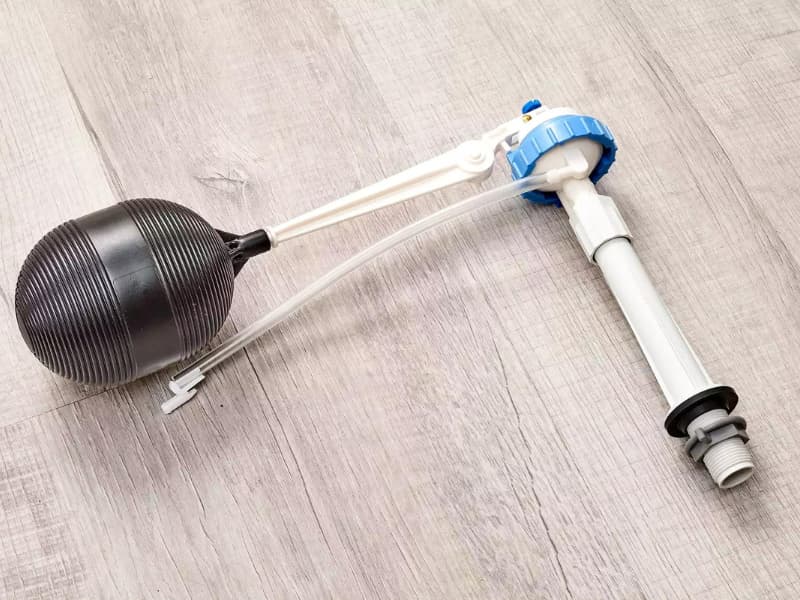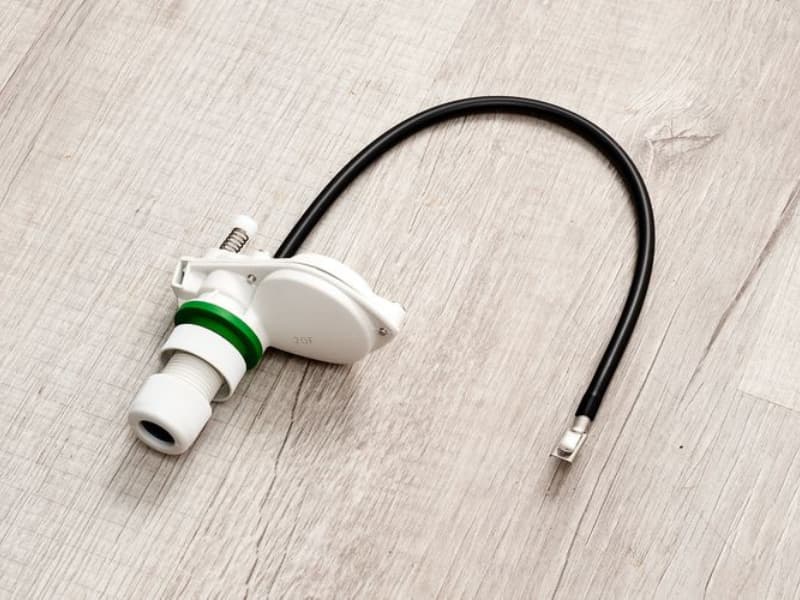The fill valve for the toilet is the most significant component of the gravity flush toilet. It regulates the water flow into the holding tank, opening the water flow as the flush cycle empties the tank and closing the water flow once the tank has been filled to the appropriate level.
The toilet fill valve regulates the flow of water into the toilet tank after a flush. The main types are the plunger (piston) ballcock, diaphragm-type ballcock (brass and plastic body types), float cup, and floatless fill valves. They differ by model, type, noise level, material, and flush rate.
You should know the types of toilet fill valves and the common toilet fill valve problems to make the most of your toilet. While it’s a small part of the toilet’s setup, it still plays a major role.

What is a toilet fill valve? How does it work?
The toilet fill valve, a collection of related components inside the toilet tank, manages the water flow that tops off the tank. Since the flush valve performs this function, it is not involved in flushing the toilet.
However, the two are connected because when you flush the toilet, the fill valve opens and lets water into the tank.
It consists of a mechanism to gauge the water level, typically a floater that rises and falls in response to the water level. The fill valve releases water when the level falls below a certain maximum point until the maximum level is attained.
Others utilize a pressure-sensing device to determine whether the toilet tank is filled with water.
The toilet fill valve doesn’t add much to the weight of the toilet but its role is one of the most important in its functioning.
Types of toilet fill valves
The main types of toilet fill valves are as follows:
1. Plunger/Piston Ballcock

One of the earliest toilet tank fill valve designs is the plunger or piston-style fill valve (ballcock). They have a robust cast brass body that allows for quiet operation.
This type of ballcock is built with a hinged lever assembly above the ballcock that frequently includes thumbscrews at some hinged joints to enable adjustment of the lever arm movement.
It also has a distinctive bottom-fill water discharge tube. These fill valves operate by opening and closing a plunger stem against a water input port using a floating ball coupled to a pivoting lever, hence the name “ballcock.”
These outdated fill valves should be changed if you still have one of them since they don’t adhere to the anti-siphon protection requirements of the most recent plumbing regulations.
2. Diaphragm-Type Ballcock (Plastic Body)

Diaphragm ballcocks have been around for a while, like plunger or piston ballcocks. They resemble brass plunger-type ball-cocks in many ways (they have float balls, too), but there are also some significant differences.
One such distinction is the anti-siphon nature of these ballcocks. They can have a cast brass body or a body made of plastic. This kind of ballcock features a diaphragm seal that opens and shuts to control water flow rather than a plunger stem with a washer that seals against the water input port.
Most recent anti-siphon diaphragm ballcocks have plastic body construction; if you decide to replace a ballcock-type valve with another, you will likely purchase one.
However, because it uses a float ball as part of its operating system, this all-plastic variety nevertheless counts as a real ballcock.
3. Diaphragm-Type Ballcock (Brass Body)

Cast brass construction includes the older diaphragm-type ballcock versions, such as the Wolverine Model 58577, which is anti-siphon, and the Mansfield 07 (now discontinued).
The bonnet or cover on an older model diaphragm ballcock is cast brass, just like the remainder of the fill valve body. However, the plastic diaphragm activation button is.
Modern plastic models are frequently used in place of brass ones today.
4. Float-Cup Fill Valve

Plastic float-cup fill valves are a more “contemporary” anti-siphon fill valve design that Fluidmaster first presented in the late 1950s.
This kind may be recognized by a plastic floating O-cup that revolves around the fill valve shaft in an upward and downward motion. A metal spring clip to a metal actuating rod holds the floating cup.
The tank water level can be changed by modifying the location of the actuating rod’s connection to the float cup.
This fill-valve design is quite common and straightforward to maintain. The vast majority of toilet fill valves available today have this design, and when it’s time to replace an old ballcock unit with a plunger or diaphragm, this is frequently the replacement of choice.
5. Floatless Type Fill Valve

The plastic floatless fill valve is a recent advancement in anti-siphon fill valves. These fill valves don’t use any float mechanism to regulate the inlet valve; instead, they use a diaphragm pressure-sensing system.
Initially created for low profile/low flow toilet tanks in the 1990s, these fill valves are often inexpensive, but the design is infamous for its patchy reliability. As a result, licensed plumbers typically avoid them in favor of float-cup fill valves.
These valves, which function underwater, are affixed to the tank’s bottom.
How to choose a toilet fill valve
Below are some of the factors you need to watch out for when selecting a fill valve:
1. Model and type
The type of fill valve you require depends on the type of toilet tank you have. To know the type of fill valve to buy while replacing your fill valve, you must first identify the previous one.
Despite the variety of flush valves available, your options may be constrained by the size of your toilet tank. As such, check thoroughly before purchasing a toilet fill valve.
2. Material
Although plastic may not always be as strong as metal, it is a better material for flush valves. Since they are resistant to rust and corrosion, plastic fill valves are more durable than their metal alternatives. Metal fill valve corrosion frequently causes leaks and malfunctions.
3. Noise level
The toilet tank makes a lot of noise when emptying and refilling, which may be rather bothersome. Therefore, buying a fill valve that offers silent operation is advisable if noise annoys you significantly and makes you irritable.
4. Fill and flush rate
While the only thing to consider might be how quickly it fills and flushes, this is different. The toilet tank’s fill valve depends on the entrance where the water enters.
Therefore, for the toilet flush valve to function at its best, the inlet must be capable of supporting the same pressure as the fill valve.
The fill valve’s flush rate and the toilet’s flush cycle are intimately related. Choose one that is compatible with your toilet’s flush process. While most modern toilets demand a three or 4-inch flush valve, most older ones can use a 2-inch one.
The flush and fill rates are also determined by the size of the toilet flapper which also plays a major role in the functioning of the toilet.
5. Other attributes
A switch between a half-flush and a full flush and ease of installation are other qualities to look for in a flush valve. The height of your fill valve should be adjustable to ensure that the size of your cistern won’t be a problem.
Water can be saved by having the option to choose between a half and full flush, and a toolless installation will eliminate the need for a plumber.
Conclusion
A toilet system that releases water into the toilet bowl has a toilet valve as a critical component. You can awaken to a bathroom with a sink and toilet that are flooded if this task isn’t done correctly.
Therefore, get a high-quality toilet valve to prevent such a problem.
Make sure it is composed of robust materials like plastic so that it’s rust and corrosion-resistant, in addition to factors like silent operation and leak-proof construction.
Identify the type and model so it can easily fit into your toilet system and has extra features like a half and full flush and an adjustable height for simple use.
